In our lab we test not only expensive smartphones but also budget cell phones. This time we are going to abuse one of the cheapest handsets available in the cell phone market: the Nokia 1616. The package box speaks for itself. There are few accessories. In the package, you’ll find the following (Pic. 1, 2):
- Battery charger
- Documentation
- The phone
The design of the phone is simple and unimpressive (Pic. 3, 4). It weighs 78 g. A 3.5 mm headphone jack can only be used to listen to the built-in FM radio. The phone is incapable of playing MP3 audio because in-built storage on this phone is very low. The handset doesn’t allow for expandable memory using a detachable memory card. The 1616 has a flashlight built into the top of the phone. The stamina of 800mAh offers an impressive amount of talk time.
The front panel is removable. It is easy to take it off.
Results
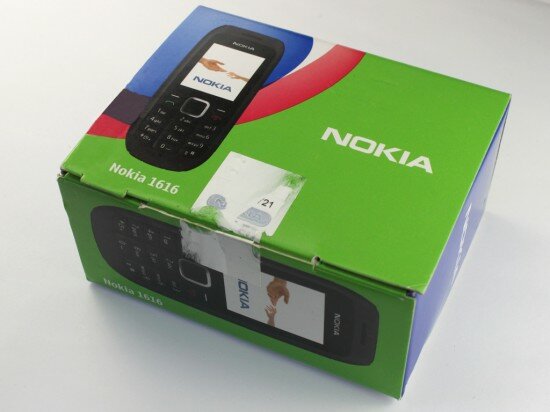
Pic. 1. Package box
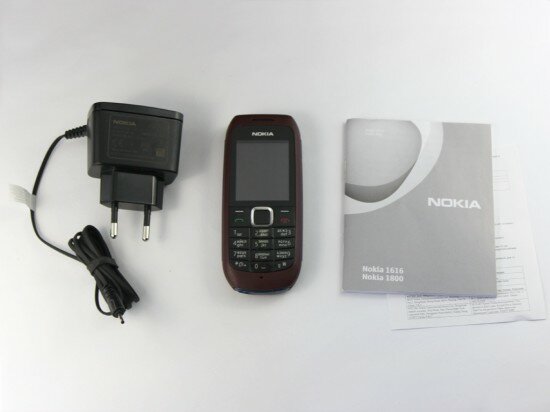
Pic. 2. Accessories
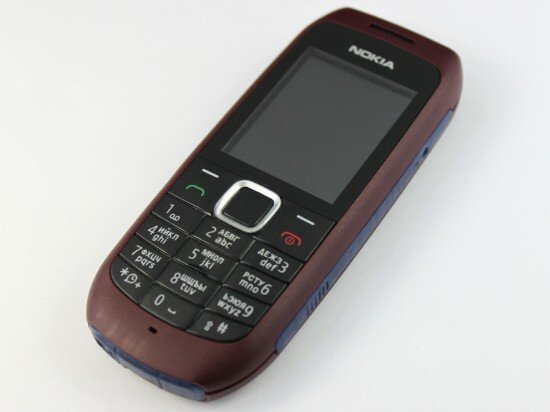
Pic. 3. The front panel of the Nokia 1616
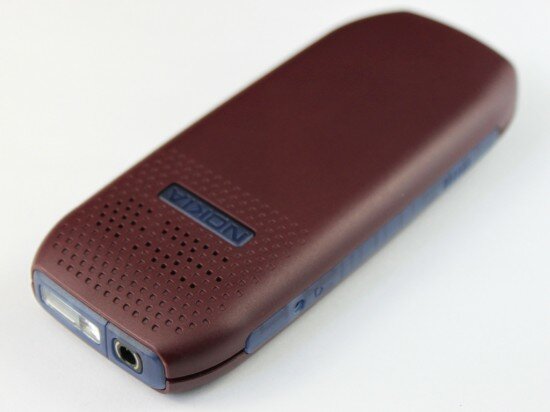
Pic. 4. The back panel of the Nokia 1616
1. Nokia 1616 stress test. Stage 1 – Light shocks
1.1 Drop test
Usually people don’t treat cheap mobile phones with care. Probably they knock and bump them oftener than expensive smartphones. The Nokia 1616’s light weight is its great advantage in comparison with other handsets. At just 78 g, it’s so light that it can stand up to the drops even from high distances.
During this test, we successively dropped the phone on the carpet (video 1) with each face, edge, and corner from 30 cm (11.8 inches) and on the tile from 1 m (3.28 ft). The Nokia 1616 passed the test very well. It showed no damage at all. The cover did not fell off.
Video 1. Drop on the carpet from 1 m (3.28 ft)
The grade is 30 (with 30 being the highest possible grade)
Video 2. Drop on the tile from 30 cm (11.8 inches)
The grade is 30 (with 30 being the highest possible grade)
1.2 Squeeze test
Sometimes people step, sit down on their cell phones and even run over them with their cars. In order to find out how the Nokia 1616 fares after such situations we placed it on a table and applied a 3 kg (6.6 lbs) pressure from a wooden bar above it (Pic. 5). We heard only the sound produced by the keys. The phone seems really solid. It successfully passed the squeeze test.
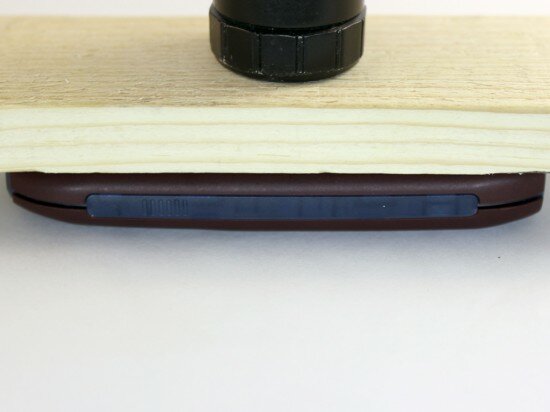
Pic. 5. The phone under the wooden bar
The grade is 24 (with 24 being the highest possible grade)
1.3 Bend test
In real life situations a cell phone can be not only squeezed but also bended. It happens because a table, a chair or whatever you put your handset on is not always flat. It can be rough. In this case the applied pressure is not distributed all over the handset. Instead, it is focused on a particular part of the phone. We could not ignore this test.
We put the Nokia 1616 onto the two planks so that each edge of the phone lies on a single plank. Then we hitched a string with 1 kg load (2.2 lbs) on top of the device. The handset sustained no sign of bend.
The grade is 24 (with 24 being the highest possible grade)
1.4 Durability
According to our experience, cell phones with matted faceplates look better than those with glazed faceplates after a long period of negligent treatment. But it does not mean that a matted faceplate is more durable than a glazed one. It is easy to scratch it. But the scratches are inconspicuous.
In order to find out what can happen to the cheap plastic exterior and the matted faceplate of the Nokia 1616 after using the phone for a long period of time, we placed the gadget inside a drum together with keys, pennies, and plastic balls to simulate what might be happening in a man’s pants pockets while carrying the handset (video 3). The drum was rotated for 5 minutes at the speed of 500 rpm.
After the test, we examined the phone. We saw small scratches all over the handset (Pic. 6). The corners of the Nokia suffered most of all. As we thought, the scratches did not strike the eye. All this damage was visible only under bright lights. The gadget looked almost like new. The screen showed the same result as all cheap cell phone screens do in this test. It got some small scratches and cracks (Pic. 7).
In general the result is good. This is the case when one may say: “Cell phones with matted textures are more durable than the glazed ones”.
Video 3. Drum rotation
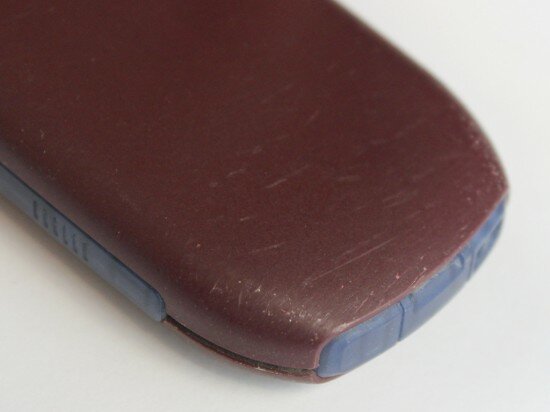
Pic. 6. Scratches on the back panel of the phone
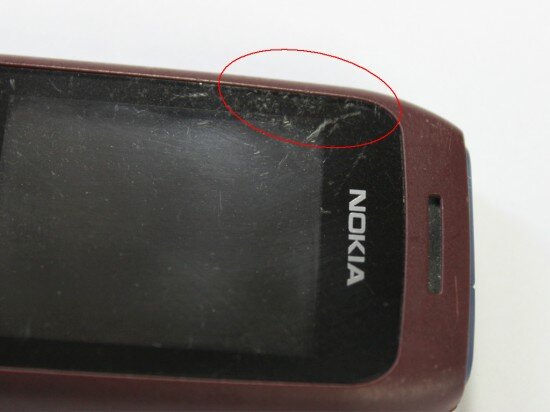
Pic. 7. Scratches on the screen
The grade is 15 (with 15 being the highest possible grade)
1.5 Scratch test
In order to find out how the screen and the back panel of the Nokia 1616 are scratchproof we put the phone under the nail installed in the machine that had been devised especially for this test. This machine scratched the screen and the back panel (video 4, 5) at the force of 100 g (0.22 lbs).
There was no sign of scratch on the screen. But the back plastic panel got a small scratch because it is not very sturdy. On the other hand this is an advantage because the gadget with this texture is less prone to cracking.
Video 4. Screen scratching
Video 5. Back panel scratching
The screen gets 15 points (with 15 being the highest possible grade)
The back cover gets 10 points (with 15 being the highest possible grade)
1.6 High temperature
Car owners who once left their cell phones on dashboards of vehicles on sunny hot days are aware of a serious danger that the sun may represent to electronic gadgets. The keypad may deform and the adhesive between the panel and the screen may melt and come out.
We performed our test by placing the device in a metallic container 5 cm from the electric bulb (40 Wt). The bulb heated the phone for 3 min (video 6). The gadget survived such test. It showed no damage at all.
Video 6. High temperature test
The grade is 12 (with 12 being the highest possible grade)
1.7 Dust test
In our review, we have a test that helps us to find out how cell phones are dustproof. There is nothing in the world that can be protected from dust. Dust can cause problems with a mobile phone even if you keep it in a pocket or in a special case.
We took an enclosed tray containing dust and threw the phone inside it. We made it vibrate viciously for 2 min. Here’s how the gadget looked like after the test (Pic. 8). Some grains of dust penetrated the screen (Pic. 9) but we took off the housing faceplate and cleaned it.
As you can see through the glass of the flashlight (Pic. 10) there is a lot of dust inside the handset. Much dust also penetrated the back cover (Pic. 11). Despite a plenty of dust and sand inside it, the phone operated with no problem. The keypad remained absolutely fine.
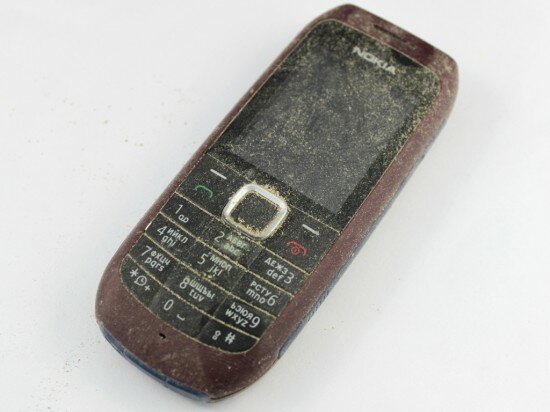
Pic. 8. Here's how the gadget looked like after the test
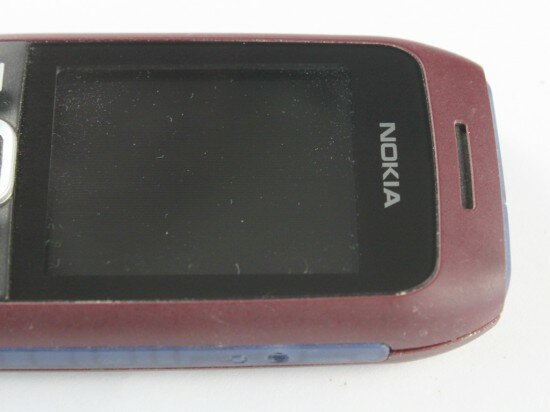
Pic. 9. Dust under the screen
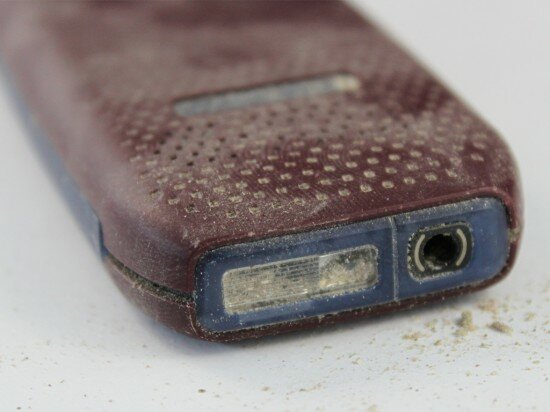
Pic. 10. Dust inside the phone
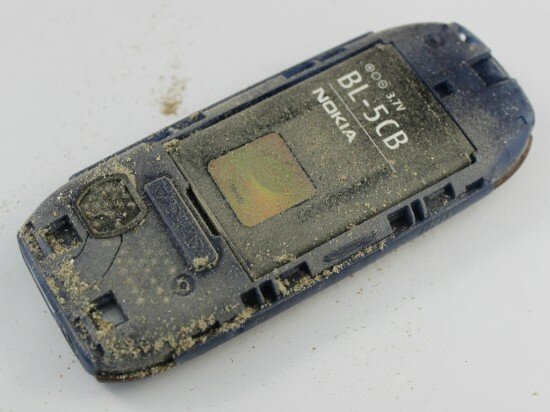
Pic. 11. Small grains of dust under the back cover
The grade is 12 (with 12 being the highest possible grade)
1.8 Connectivity
The main function of any cell phone, especially a cheap one, is to make and receive calls. That is why we carried out a connectivity test. We placed the handset inside a box. Then we foiled the box (the foil served as a shield) and made a 40 x 45 mm (1,57 x 1,77 inches) hole in it.
This, however, reduced the signal a bit. But the Nokia 1616 showed a good result. It received all the incoming calls when it was in the shielded box (video 7). The indicator of signal strength displayed only 3 bars from a maximum possible signal strength of 5.
Video 7. Connectivity test
The grade is 15 (with 15 being the highest possible grade)
After the 1st stage of the stress test, the Nokia 1616 got 187 (with 192 being the highest possible grade)
2. Nokia 1616 stress test. Stage 2 — Tough conditions
2.1. Drop test
We made this test tougher. The height of the drop on the carpet was 1.5 m (4.9 ft) and the height of the drop on the tiles was 50 cm (1.64 ft) (video 8, 9).
When the phone fell on the carpet the battery fell out of its slot. But when we dropped the gadget on the tile only the back cover fell off – the battery remained in the slot. After the test the handset stayed functional. It showed no damage. But we heard a noise from within the phone. It was produced by the loudspeaker that had been loosened up. Some dust remained inside the phone. The grains of dust, that hsd penetrated the handset in the dust test, moved to the display and covered it (Pic. 12).
Video 8. Drop on the carpet from 1.5 m (4.9 ft)
Video 9. Drop on the tile from 50 cm (1.64 ft)
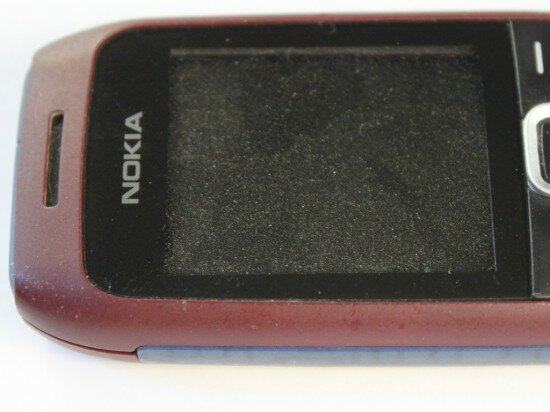
Pic. 12. Dust on the display
The grade for the drop on the carpet is 30 (with 30 being the highest possible grade)
The grade for the drop on the tile is 30 (with 30 being the highest possible grade)
2.2 Squeeze test
In this test, we increased the applied pressure to 10 kg (22 lbs). Just like the previous squeeze test, the Nokia 1616 sustained no damage. It showed no deformation at all.
The grade is 24 (with 24 being the highest possible grade)
2.3 Bend test
This time, we increased the load to 5 kg. We found a small bend on the Nokia 1616 but the phone stayed functional.
The grade is 24 (with 24 being the highest possible grade)
2.4 Durability
We increased the time of this test. We examined our device after it had spent 10 min in the rotating drum. The screen, the front and the back panel got a bit more scratches and cracks than in the previous test, but none was deep (Pic. 13).
We can infer that the absence of sputtering on the phone is a recipe for success in a durability test.
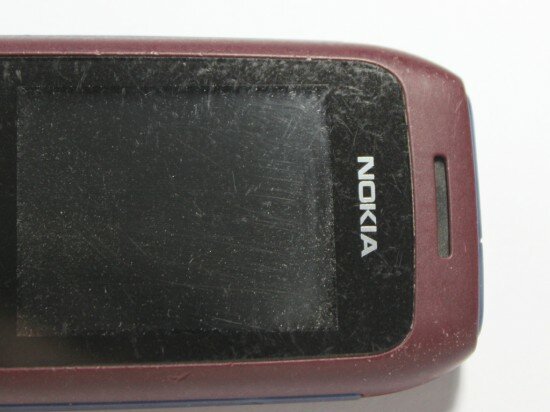
Pic. 13. Scratches on the screen
The grade is 24 (with 24 being the highest possible grade)
2.5 Scratch test
This time, the machine scratched the Nokia 1616 at the force of 300 g (0.66 lbs). The scratch was a bit deeper in comparison with the one made in the previous scratch test. The scratch on the screen was almost the same (video 10, 11).
Video 10. Screen scratching
Video 11. Back cover scratching
The screen gets 10 points (with 15 being the highest possible grade)
The back cover gets 10 points (with 15 being the highest possible grade)
2.6 Freeze test
Those people who happened to speak on the phone for a long time in cold weather know that cell phone batteries deplete quicker compared to moderate temperatures. By the way, the screen may malfunction in cold weather.
In order to check the performance of the Nokia 1616 in such an environment, we did the following: we took a box filled with ice cubes, placed the handset in it, and then placed the box in a freezer for 2 hours. The temperature in the freezer fluctuated from -15 to -20 оС (from 5 to -4 °F). The phone was left in speaking mode during that time.
After the test, we examined the phone (video 12) and found out that the display malfunctioned. The capacity of the battery went down by one bar, a rather small drop.
Video 12. Freeze test
The grade is 18 (with 18 being the highest possible grade)
2.7 High temperature
In this stage of the test, we increased the time of heating to 5 min. When we took the Nokia 1616 out of the container we saw that the keyboard deformed. But the screen did not become dim. The quality of the display stayed normal. We cooled down the handset, then the keyboard returned to its original shape. The gadget performed pretty fine.
The grade is 12 (with 12 being the highest possible grade)
2.8 Immersion in water
There is no doubt that liquid is the worst enemy of any gadget. There are cell phones that can be broken just by holding them with your moist hands. In this test, we found out how waterproof the Nokia 1616 is. We dunked it under water for 1 second (video 13).
We already know that this phone is not dust resistant. However, it passed the test in water successfully. The only thing that disappointed us was the loudspeaker: it got wet and we heard barely any sound (Pic. 14). Little water penetrated under the back cover. The battery stayed dry. We dried the phone. Afterwards, the loudspeaker performed fine again.
Video 13. Immersion in water for 1 sec
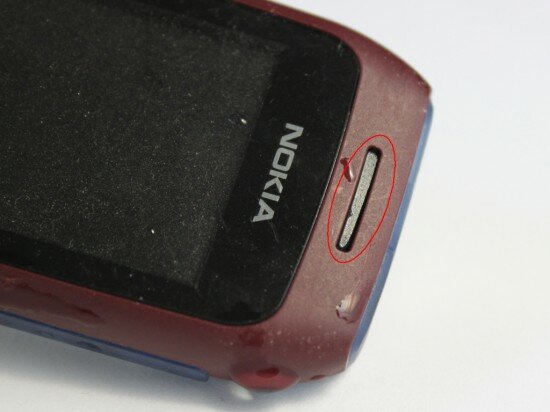
Pic. 14. The loudspeaker got wet
The grade is 30 (with 30 being the highest possible grade)
2.9 Dust test
In the previous dust test the grains of dust penetrated everywhere. But now we made this test tougher. This time, our machine shook the enclosed tray containing the Nokia 1616 and dust for 5 minutes.
The result was the same as in the previous dust test with the difference that more dust got under the back cover. A lot of dust stuck to the loudspeaker since it is not set very deep inside the handset (Pic. 15). But the sound remained normal.
The keypad kept out all the dust and operated with no problem.

Pic. 15. Dust under the back cover and in the loudspeaker
The grade is 12 (with 12 being the highest possible grade)
2.10 Connectivity
We decreased the size of the hole to 20 x 20 mm (0,787 x 0,787 inches). This reduced the signal considerably. In fact, the signal indicator displayed only 1 – 2 bars (video 14). But the Nokia 1616 received all the oncoming calls with no problem.
Video 14. Signal strength test
The grade is 15 (with 15 being the highest possible grade)
After the 2nd stage of the stress test, the Nokia 1616 got 230 (with 240 being the highest possible grade)
3. Nokia 1616 stress test. Stage 3 – The toughest conditions
3.1 Drop test
At the last stage of the stress test, we dropped the Nokia 1616 on the carpet (video 15) from 2 m (6.56 ft) and on the tile (video 16) from 1 m (3.28 ft). The battery fell out each time when the phone fell on the carpet and on the tile and each time we had to put it back in the slot and fit in the back cover. But the handset showed no damage at all. The screen was also pretty fine.
Video 15. Drop on the carpet from 2 m (6.56 ft)
Video 16. Drop on the tile from 1 m (3.28 ft)
The grade for the drop on the carpet is 30 (with 30 being the highest possible grade)
The grade for the drop on the tile is 30 (with 30 being the highest possible grade)
3.2 Squeeze test
In this test, we increased the pressure we applied to 20 kg (44 lbs). Despite this high pressure the phone passed the test successfully. The Nokia 1616 sustained no damage.
The grade is 24 (with 24 being the highest possible grade)
3.3. Bend test
This time, we applied 10 kg (22 lbs) weight in our attempt to bend the Nokia 1616. It showed a clear sign of bend (Pic. 16). The absence of a metal frame inside the casing and light weight helped the handset to survive.
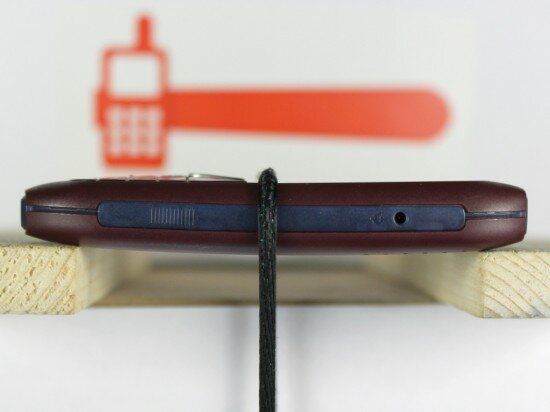
Pic. 16. Bend made by the 10 kg (22 lbs) load
The grade is 24 (with 24 being the highest possible grade)
3.4 Durability
It was time we used the drum for the last time in this stress test. We rotated it for 20 min. The results we got were not worse than in the previous tests. The back cover seemed fine (Pic. 17). If you don’t know that it was flat before the tests you might think that this is how it should be. Only the scratches at the corners indicated that the phone wasn’t new (Pic. 18). The screen got more cracks and scratches than in the previous tests (Pic. 19). But the big granularity of the display made all the cracks inconspicuous.
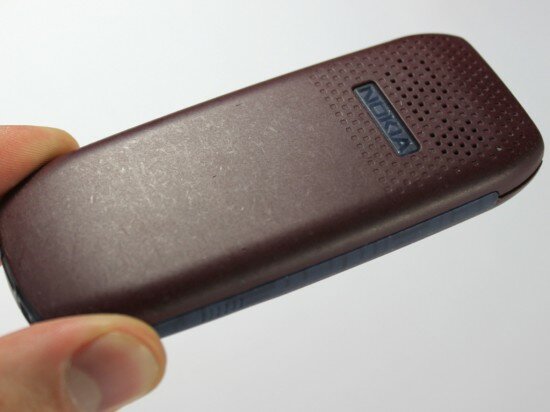
Pic. 17. The back panel after the test

Pic. 18. Scratches at the corners
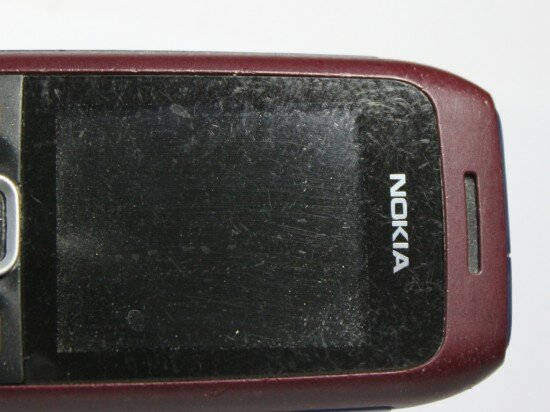
Pic. 19. Cracks and scratches on the screen
The grade is 15 (with 15 being the highest possible grade)
3.5 Scratch test
This time, the force of scratches was twice compared to the previous scratch test — 600 g (1.322 lbs). The scratches on the back panel and on the screen were twice as big as in the previous scratch test (Pic. 20, 21). The quality of the display was spoiled by the newly made scratch and by the scratch made in the previous scratch test (Pic. 22).
Video 17. Back panel scratching
Video 18. Screen scratching
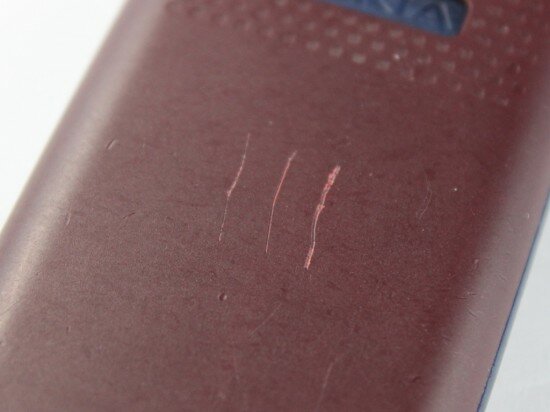
Pic. 20. Scratches on the back panel
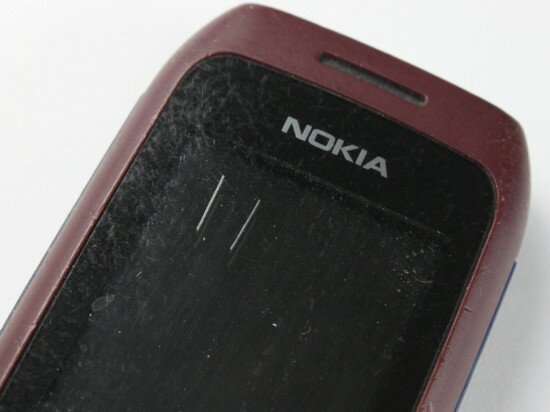
Pic. 21. Scratches on the screen
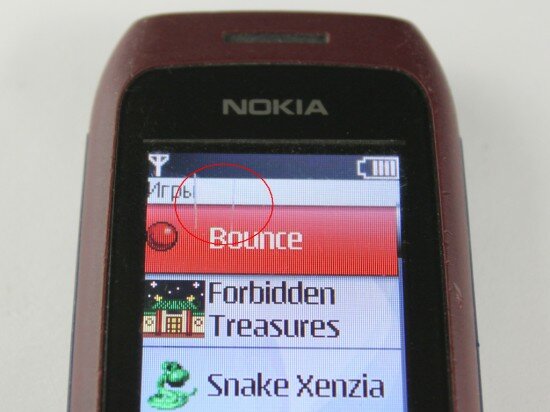
Pic. 22. Scratches that spoil the quality of the display
10 points (with 15 being the highest possible grade) for the screen
10 points (with 15 being the highest possible grade) for the back cover
3.6 High temperature
We increased the time of this test to 10 min. When we took the gadget out of the container we saw that the keyboard deformed (video 19). The “2” and “5” keys melted a bit (Pic. 23). We looked at the phone closer and saw that the screen also deformed. To our surprise the display did not become dim as it often happens to the majority of cell phones that we test. We cooled the handset down and the keyboard returned to its original shape but some keys remained melted.
Video 19. High temperature test

Pic. 23. Damage of the keyboard
The grade is 8 (with 12 being the highest possible grade)
3.7 Immersion in water
The Nokia 1616 survived 1 minute immersion in water with no problem. But in this test, we dunked the phone under water for 20 sec. The result was the same as in the previous test: the loudspeaker got wet and we heard barely any sound again (video 20). Less water penetrated the handset than in the previous test. But it stayed functional. We dried the phone for an hour. Afterwards, the loudspeaker performed pretty fine.
Video 20. Immersion in water for 20 sec
The grade is 30 (with 30 being the highest possible grade)
3.8 Immersion in beer
This time, we used beer that is much better conductor than water. We dunked the Nokia 1616 under beer for 10 sec (video 21) and this did not damage the handset. Watch video 20 to witness how the beer ran out of the the ear-microphone jack and the charger jack. However, the phone did not identify the headphones (the majority of handsets with mini-jacks identified the headphones when the headphones were not plugged in). The beer penetrated under the back cover but not under the battery. After the test, we washed and dried the handset. Then we examined it: the device showed no damage at all.
Video 21. Immersion in beer
The grade is 9 (with 9 being the highest possible grade)
3.9 Dust test
We increased the time of this test to 10 min. The result was similar to that of the previous dust tests. We saw small grains of dust under the screen and inside the phone (we saw dust through the glass of the flashlight). A lot of dust penetrated under the back cover.
But we easily cleaned all the dust. It was difficult to clean the display, though. Dust penetrated the phone and then moved to the display.
The grade is 12 (with 12 being the highest possible grade)
3.10 The keypad
The Nokia 1616 has the all-in-one key mat that is made of rubber. Its quality is worse than that of the plastic keyboards. You can understand it if you expose this handset to etreme weather conditions. The main reason why manufacturers continue to supply cell phones with this keypad is its low production cost.
The keypad of the Nokia 1616 is uncomfortable to use. But we should say that it operated with no problem during all the tests. The keyboard was deformed by the heat and malfunctioned after the freeze test but soon it returned to its original state.
The grade is 30 (with 30 being the highest possible grade)
3.11 Connectivity
We decreased the size of the hole in the shielded box to 15 x 15 mm (0,59 x 0,59 inches). The indicator of signal strength fluctuated greatly but the handset received all incoming calls (video 22).
Video 22. Connectivity test
The grade is 15 (with 15 being the highest possible grade)
3.12 Short circuit and overcharge
At first we found out what would happen to the battery charger if we made a short circuit of the power supply terminals with the help of the forceps for 1 sec. Watch video 23 to witness that the battery charger stayed functional.
Video 23. Short circuit of the battery charger
The grade is 15 (with 15 being the highest possible grade)
Then we made a short circuit of the battery for 1 sec (video 24). The battery stayed absolutely safe and did not even deplete.
Video 24. Short circuit of the battery
The grade is 15 (with 15 being the highest possible grade)
Next, it was the turn for the Nokia 1616 to be tested. At first, we plugged the battery charger in the PSU and checked the reaction of the gadget to the increase and decrease in charging voltage within the range of 3–8 V (video 25).
When we decreased the charging voltage to 3.8 V, the phone stopped charging. This is an average result.
Then we increased the charging voltage. We saw that the more we increased the voltage the more increased the gadget’s power consumption. When we reached 8 V the power consumption was 1 A.
It means that a broken battery charger can damage the Nokia 1616 and its battery. The worst thing that might happen is fire. The battery charger may also explode. The handset stopped charging automatically but the voltage was too high at that moment. The Nokia 1616 stayed absolutely safe.
Video 25. Increase/decrease of charging voltage
The grade is 10 (with 15 being the highest possible grade)
Finally, we examined the phone’s energy consumption. We took the battery out and plugged the PSU in the phone. At first, we decreased energy supply until the gadget switched off. We did that in order to find out the minimum voltage supply. The Nokia 1616 switched off when we reached 2.8 V. This is a good result.
We decided that the maximum voltage supply should be 7 V and started increasing energy supply till we reached this point. The gadget’s power consumption did not increase rapidly. When we reached 7 V the phone stayed functional.
Video 26. Increase/decrease of voltage supply
The grade is 15 (with 15 being the highest possible grade)
3.13 Disassembling
After all the tests, we disassembled the Nokia 1616. It has an uninspiring build quality that indicates the low price of the phone. As you cay see from picture 24, the phone consists of few components.
The circuit board occupies all the area inside the gadget. But it has a lot of empty spaces. We can’t blame the manufacturers because this design saves their money and time. They see no point in economizing space inside the phone.
The components of the board are protected by the nonremovable shields. The display can’t also be removed from the circuit board (Pic. 26). As far as we can judge, the Nokia 1616 is a disposable mobile phone. It’s easier to throw it away when it’s broken than to try to repair it. Probably that was the goal of the manufacturer.
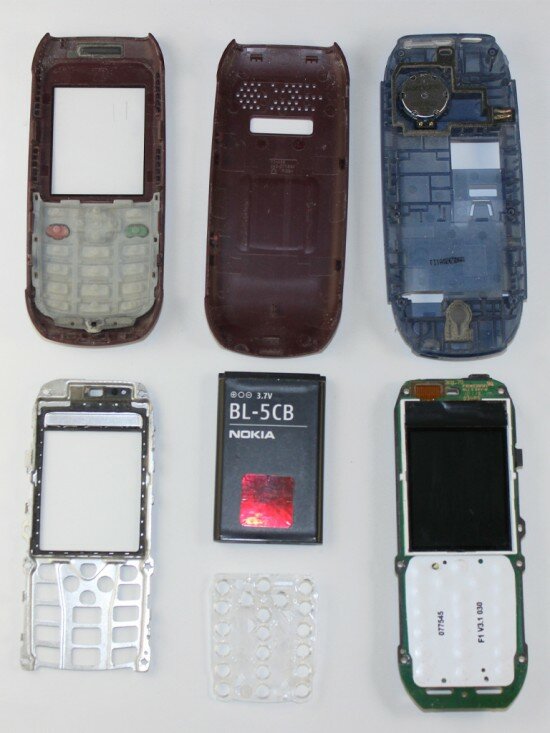
Pic. 24. The Nokia 1616 disassembled
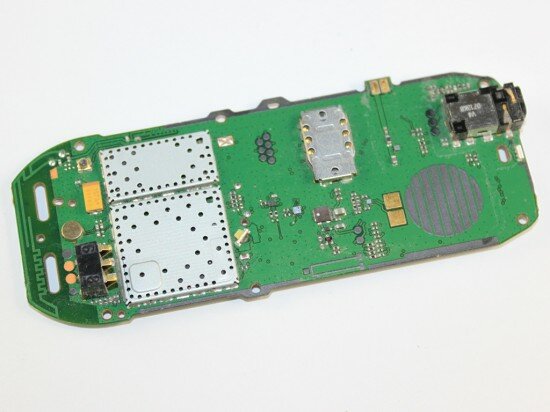
Pic. 25. The circuit board of the Nokia 1616
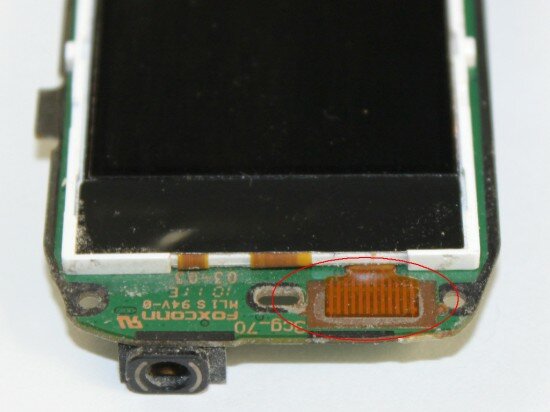
Pic. 26. Connection of the circuit board with the display
The grade is 10 (with 15 being the highest possible grade)
After the 3rd stage of the stress test, the Nokia 1616 got 322 (with 351 being the highest possible grade)
Conclusion:
The Nokia 1616, one of the cheapest handsets on the market, outperformed a lot of expensive smartphones. It stayed absolutely fine after immersion in water and beer. But the result of the dust test was not so good. We can say that the phone is waterproof but not dustproof.
Due to its light weight, the Nokia 1616 passed the drop test successfully. The matted panels and the absence of sputtering make the handset quite durable: we saw few scratches and cracks after the test in the drum. However, we can’t but mention again that this is a disposable device. And this is made on purpose. The phone may also malfunction in extremely hot or cold weather. Take it into consideration if these factors are important for you.
Here’s how the gadget looks like after all the tests (video 27, pic. 27, 28).
Video 27. Here’s how the gadget looks like after all the tests
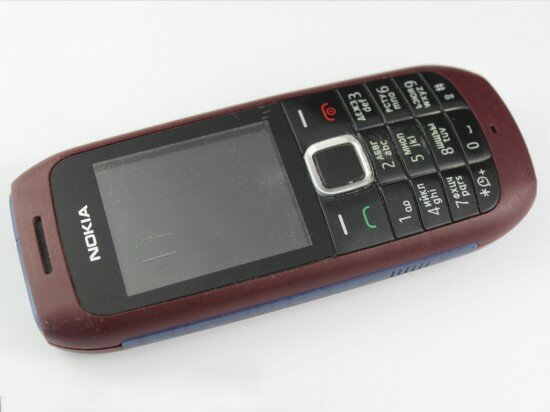
Pic. 27. The front panel of the Nokia 1616 after the test
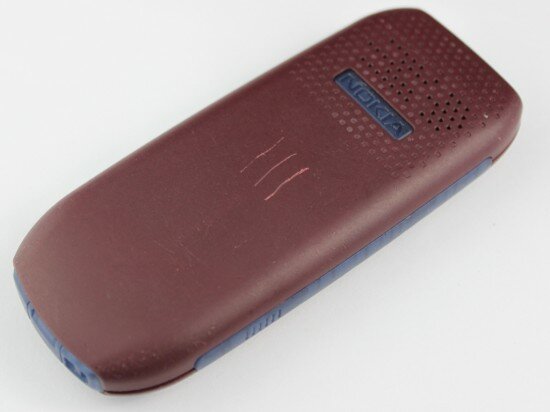
Pic. 28. The back panel of the Nokia 1616 after the test

 Russian version
Russian version
Comments (2)
will it blend?
What a great job you all are doing, very interesting to see it all. I will buy this phone to my father and I think he would be happy. Just thanks to your stress test. Is it possible to get tests of all the phones that you put through the same way? Thank you. Have a great week. Best regards Roger Pedersen, Norway